Green Hydrogen
Opportunities for India | January 2023
Context & Prevailing Global Scenario:
Hydrogen is a chemical element available in abundance. The hydrogen available today is either extracted through fossil fuels or natural gas, making the process of extraction extremely polluting.
The chart below shows the different forms of hydrogen being used currently.
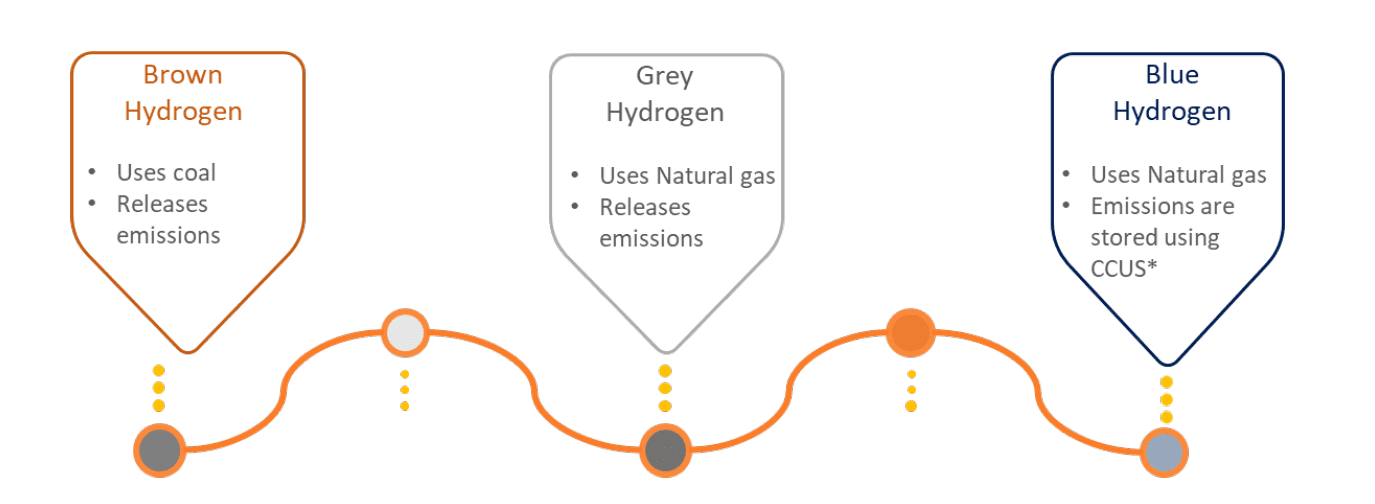
*Carbon Capture, Usage and Storage
To extract hydrogen in its purest form, water is electrolyzed through energy produced by renewable sources. This process of electrolysis splits the molecule into its two constituent elements and the hydrogen obtained thereafter is called green hydrogen.
Global scenario
After witnessing a 5% decline in 2020, the annual global carbon emissions rose by 6% in 2021 to reach 36.4 billion metric tonnes, their highest-ever levels.1 The rise was due to a recovery in manufacturing activities along with a recovery in energy demand, leading to more coal being burnt despite renewable power generation registering its largest-ever annual growth during this period.
The chart below shows the percentage share of annual global carbon emissions for emerging and advanced economies. Emerging economies include China, Russia, India, Brazil, South Africa whereas advanced economies include U.S, E.U, U.K and Canada.
Chart 1 : Annual global emissions of carbon dioxide (2001-2021)
Chart 2 : % share of global carbon emissions – Emerging vs Advanced Economies
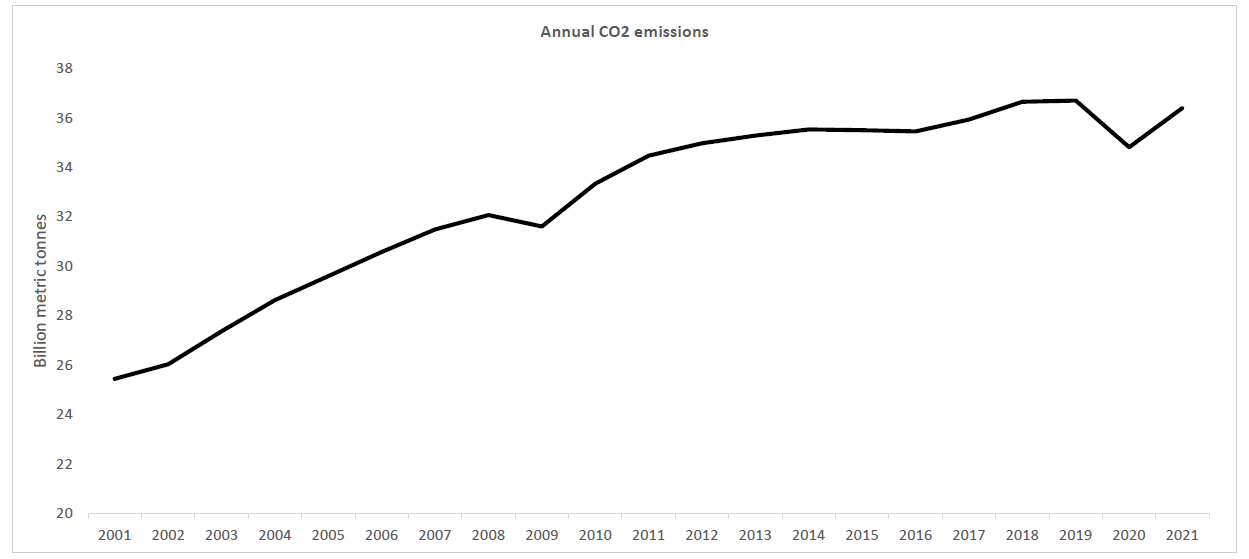
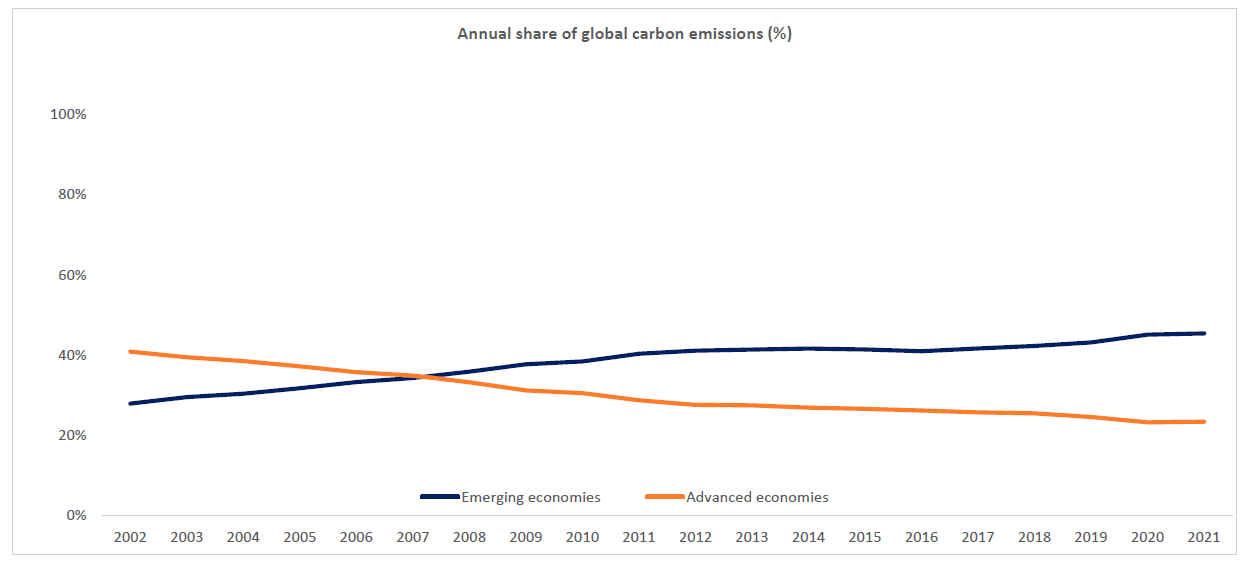
Source : Statista
Source: Our World in Data
There has been an increased consensus around the world to bring global warming levels to less than 2 degrees and if possible, to cap it at 1.5 degrees higher than pre-industrial levels. Various countries have pledged their Nationally Determined Contributions to reduce their current emission levels. This has been followed by the adoption of various technologies that provide alternatives to traditional modes of power generation and industrial production.
A key technology being explored to curb global emission levels is green hydrogen. Being an excellent energy carrier with respect to weight, hydrogen has certain advantages over traditionally polluting resources. One kilogram of hydrogen contains about 33 KWh of usable energy whereas petrol and diesel contain only 12 KWh per kilogram. Various countries have made substantial progress towards using green hydrogen in a bid to transition to a low-carbon world.
Green hydrogen for India (Net-Zero emissions by 2070)
The recently concluded Conference of Parties (COP27) saw India submitting its Long-Term Low Emission Development Strategy (LT LEDS) to the United Nations Framework Convention on Climate Change (UNFCCC). With this submission, India joined the select list of 60 parties that submitted their LT LEDS to the UNFCCC. The strategy focused on transitioning from fossil fuels in a smooth, sustainable, and all-inclusive manner.
The use of green hydrogen would help India achieve its global decarbonization targets of becoming a net-zero India by 2070. India’s push towards a low-carbon economy comes at the back of a competitive advantage in generating electricity through renewable sources. Since green hydrogen can be produced anywhere there is ample renewable potential, a fast-growing renewable industry provides adequate opportunity for enhancing the scope of green hydrogen projects in the country.
Chart 3 : Month-wise installed generating capacity of renewable and conventional sources in India
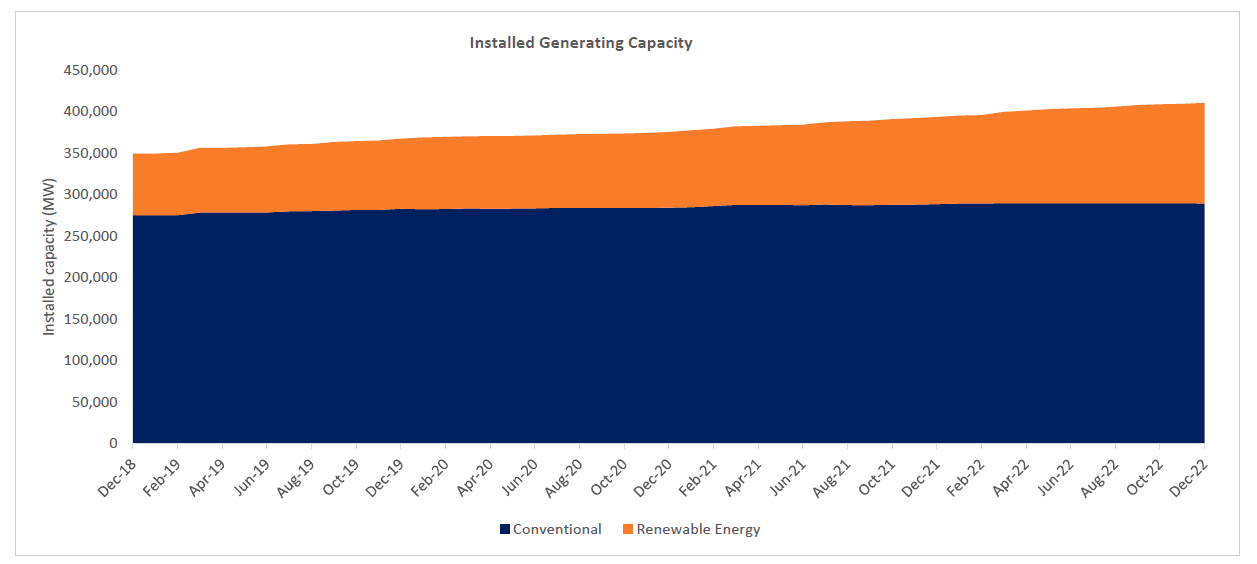
Source : CMIE Economic Outlook
The transition to a low carbon economy entails many benefits for India, some of which are as follows:
1. Decarbonizing the energy sector
The energy sector, comprising electricity, heat, transport, and industrial processes contributes three-fourth to the total greenhouse gas emissions.2 This highlights the need to decarbonize the sector and replace conventional methods of generating electricity with renewable sources.
With a CAGR of 11% over the last five years, renewable energy has increased its contribution to the overall electricity generated and is expected to rise further.
However, a major challenge to this growth remains the dependence of renewable energy sources on weather conditions, with solar power dependent on solar radiation and wind power dependent on wind speed.
In cases of a mismatch between power generated and power consumed, a risk of grid instability befalls the renewable energy sector. To eliminate this risk, there is a need for an energy storage mechanism. Hydrogen fuel cell (HFC) can play a key role as an electro-chemical energy storage technology for power produced through renewable sources. This will further enable the penetration of more renewables into grids.
2. Decarbonizing the energy sector
From FY16 to FY22, India’s imports of oil and natural gas have more than doubled from INR 4.5 lakh crores to INR 10 lakh crores. While higher imports dent the overall trade balance situation of the country, they also entail huge energy dependence. The use of green hydrogen can help bring India’s energy import bills under control. Besides the financial savings, it can also help in making India an energy independent nation. The energy security that green hydrogen provides will translate to less volatile price inputs as well as strengthen India’s foreign exchange position in the long run.
Chart 4: India’s annual crude oil and natural gas imports in value terms.
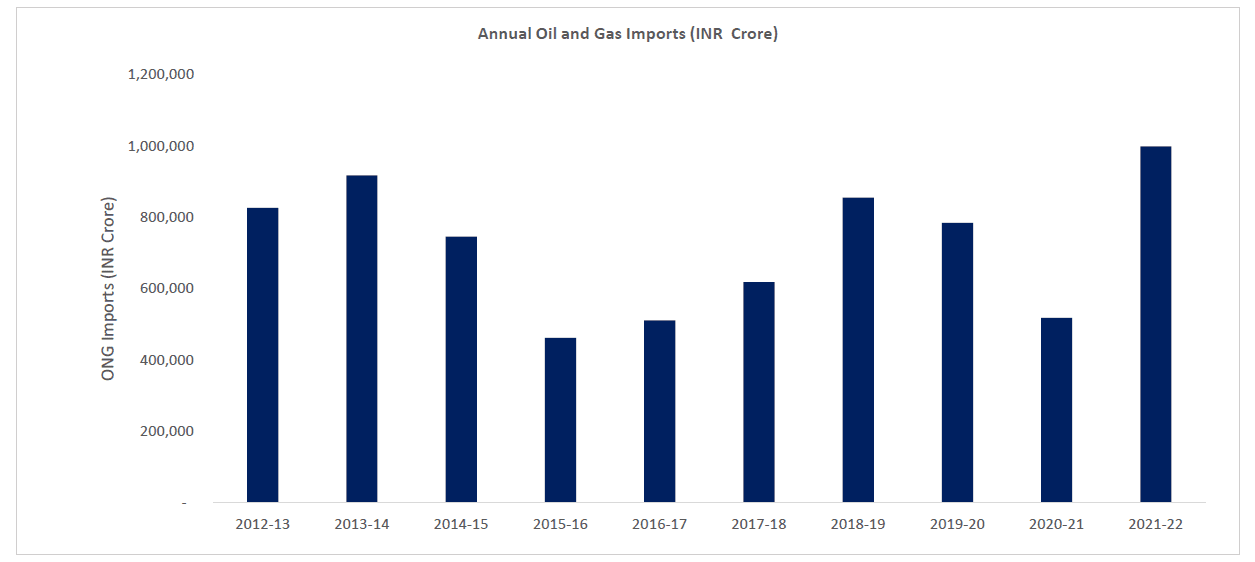
Source : Ministry of Petroleum and Natural Gas
3. Competitive advantage of Renewable Energy
India has one of the highest rates of growth for renewable energy in the world. 3 Over the last seven years, the percentage share of renewable energy in power generation has almost doubled. The installed renewable energy capacity too, has increased by two and a half times during this period. In addition to this, a decrease in tariffs of renewable energy sources due to lower project costs has made renewable energy an economical source of power generation. India’s distinct advantage in low-cost renewable energy generation makes green hydrogen, the most competitive form of hydrogen in the long run. This also enables India to be one of the most competitive producers of green hydrogen in the world.
Chart 5 : Tariffs of solar and wind power (INR per Kilowatt Hour)
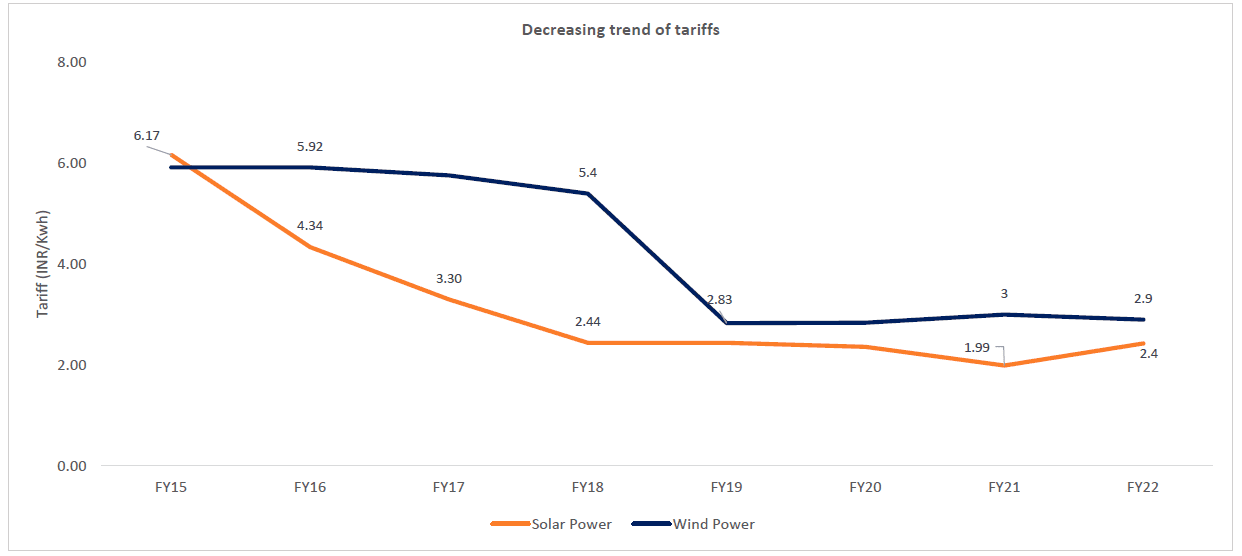
Source : Ministry of New and Renewable Energy
Government Support
The beginning of CY’23 saw an allocation of INR 19,744 crore towards the government’s Green Hydrogen Mission. The proceeds of the amount would be directed towards conducting pilot projects, Research and Development and setting up a manufacturing base for electrolyzers and other green hydrogen equipment.
The Green Hydrogen Policy announced in the beginning of CY’22 was a major impetus to the manufacturing of green hydrogen, with a focus on boosting the domestic production of green hydrogen to 5 million tonnes per annum by 2030 and making India an export hub for green hydrogen.
Key measures of the policy include the following:
1. Open access to the Inter State Transmission System
Cost of transmission constitutes about 25 to 35 percent of the cost of green hydrogen. The transportation of hydrogen in the form of molecules over long distances entails huge costs. The Hydrogen Policy provides for free and easy open access to the Inter State Transmission System, for 25 years for capacity installed by June 2025 for green hydrogen production. Grid connectivity for green hydrogen power plants has been given a priority by the power ministry.
2.Single Window Clearance
Through a single window clearance, a green hydrogen producer can apply for requisite clearances within a single registration interface. Through a single portal established by the Ministry of New and Renewable Energy (MNRE), all statutory clearances concerning manufacturing, storage and transportation of hydrogen will be granted in a swift manner within 30 days of application.
3.Renewable Purchase Obligation
A Renewable Purchase Obligation mandates all power distribution companies (Discoms) to purchase or produce a minimum specified quantity of their requirements from Renewable Energy Sources. Discoms now have been allowed to procure renewable energy to supply green hydrogen producers at a concessional rate, with the same being included under their Renewable Purchase Obligations (RPO).
Expected demand/ end-user industries
At present, hydrogen is being primarily produced with the help of fossil fuels for use in the chemical, steel, and refinery industry. If these sectors replace their current usage of hydrogen and ammonia with green hydrogen and green ammonia, the industrial sector’s carbon emissions of 144 million tonnes per annum can come down significantly. The ease of producing hydrogen through renewable electricity will match the demand generated from industrial sector.
Major sectors contributing to carbon emissions in India include power, construction, and transportation.
Chart 6 : Sector-wise carbon dioxide emissions
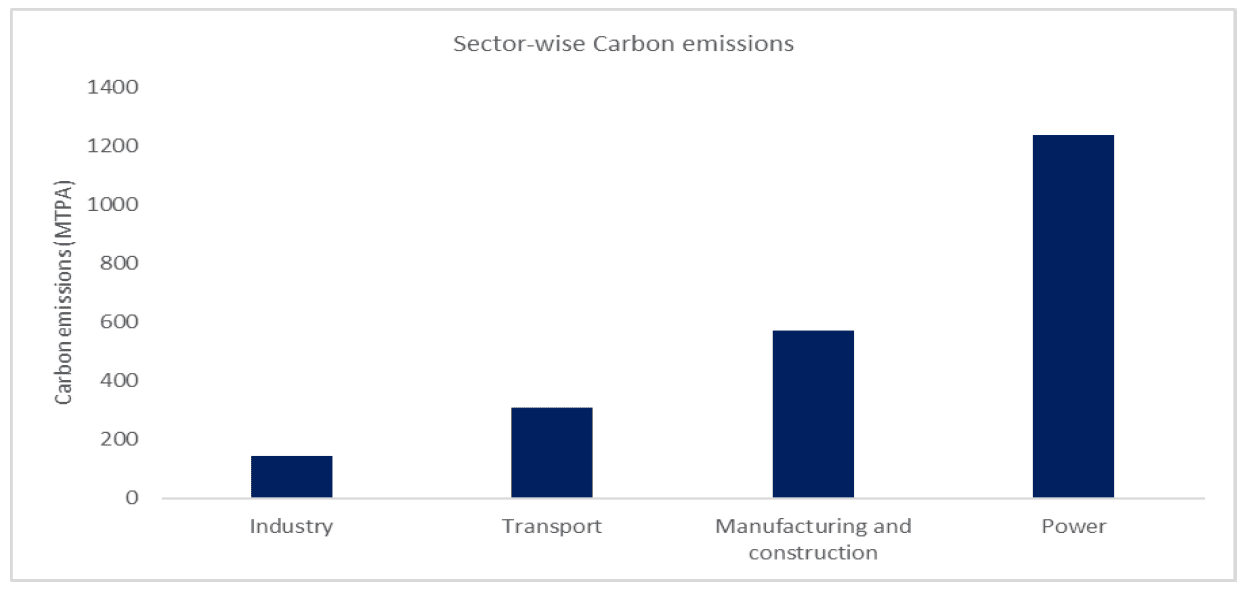
Source: Our World In Data
Transport
Imports of fuel oil in India increased to 0.63 million tonnes in October’22 from 0.56 million tonnes in September’22. 4 Besides being import dependent, the transport sector is also one of the most polluting. Powering fuel-cell vehicles is one of the leading use cases for green hydrogen. This can play an important role in certain transportation segments like heavy-duty vehicles as well as light vehicles. For heavy-duty vehicles, the use of hydrogen entails great advantage due to its high energy intensity which is around three times more than diesel or gasoline. Fuel-cell Electric Vehicles (EV’s) also have an advantage in terms of wastage of energy generated. Half the energy generated by an internal combustion engine is wasted as heat, whereas Fuel Cell EV’s only lose 10%.
Power
The power sector is the highest emitter of carbon dioxide. However, over the last five years, the increasing use of renewable sources in power generation has opened up the demand prospects of hydrogen fuel in the sector. Currently, the use of Power-H2 -Power is being professed by energy experts to provide storage and flexibility to the grid. Power-H2 -Power involves storing hydrogen, either chemically or physically, in times of excess generation. At the time of need, the excess hydrogen is discharged either through gas turbines or fuel cells.
Challenges to green hydrogen transition
1.Cost of production
In the current scenario, usage of green hydrogen is unfavorable, with green hydrogen production cost being higher than fossil fuels. Green hydrogen production cost ranges between INR 320-330 per kilogram. Industry professionals expect this cost to halve to INR 160-170 per kilogram by 2030. This cost of production includes operational and capital expenditure, as well as energy costs. While capital and operational expenditure can be estimated easily, energy costs, constituting 50-65% of the cost of production, depend on highly volatile input prices. The green hydrogen policy exempts Inter State Transmission System charges. However, a further waiver of Transmission and Distribution charges would be critical in bringing down the overall cost of production
2.Unclear regulations and standards
Green hydrogen is an emerging technology, with many regulations being unclear. There is a need for revisiting current hydrogen production standards and implementing new regulations to enable a quicker transition to a hydrogen economy. There is also a need for demand and supply side initiatives, with demand side initiatives helping ease the high cost of production and supply side initiatives focusing on improving infrastructural requirements.
3.Transportation and storage
Transporting and storing hydrogen is highly capital intensive and requires a massive infrastructure development. Although technical developments for storage (storage tanks, chemical storage) and transportation (pipelines, trucks, tanker ships) are being undertaken currently, each has their own limitations, in terms of availability, chemical characteristics etc.
Outlook
Green hydrogen as an energy storage solution in the power sector, as well as its uses in Fuel Cell Electric Vehicles can be a major gamechanger. If the green hydrogen policy is implemented well in a phase-wise manner, India’s carbon emissions can plummet significantly by 2070. Continued policy push, investments towards research and development projects and government support would be required to explore the potential of green hydrogen in the country.
To compensate for the increasing input costs i.e., electrolyzer prices, financial support would be required to boost electrolyzer manufacturing within the country.
Careful implementation of the policy along with technological advancements to ensure efficient storage and transportation systems would be critical for scaling the use of hydrogen required for a net-zero India.
Sources:
1.Annual CO2 emissions worldwide 1940-2021 | Statista
2.Emissions by sector – Our World in Data
3.MNRE Annual Report 2020-21
4.India Imports of Fuel Oil – December 2022 Data – 2014-2021 Historical (tradingeconomics.com)
5.Harnessing_Green_Hydrogen_V21_DIGITAL_29062022.pdf (niti.gov.in)
6.KPMG-in-India_Indias-green-hydrogen-ambition-Setting-the-wheels-in-motion_compressed-11-15.pdf (eqmagpro.com)
TruQuest is knowledge series launched by TruBoard Partners providing succinct updates and views on:
- Liquidity outlook
- India’s macro economic view
- Trends within the infrastructure, Real Estate and Renewable Energy sectors
- Impact analysis of new regulations and policies on lending and capital flow
Team:
Nandkumar Surti, Co-Founder
Ria Rattanpal, Research Associate
Sudhakar Sundaray, Head-Technology & Engineerin
Tilkesh Purohit, Associate Vice President
Team:
Nandkumar Surti, Co-Founder
Ria Rattanpal, Research Associate
Nandkumar Surti, Co-Founder
Ria Rattanpal, Research Associate
Sudhakar Sundaray, Head-Technology & Engineerin
Tilkesh Purohit, Associate Vice President
Disclaimer
The data and analysis covered in this report of TruQuest has been compiled by TruBoard Pvt Ltd and its associates (TruBoard) based upon information available to the public and sources believed to be reliable. Though utmost care has been taken to ensure its accuracy, no representation or warranty, express or implied is made that it is accurate or complete. TruBoard has reviewed the data, so far as it includes current or historical information which is believed to be reliable, although its accuracy and completeness cannot be guaranteed. Information in certain instances consists of compilations and/or estimates representing TruBoard’s opinion based on statistical procedures, as TruBoard deems appropriate. Sources of information are not always under the control of TruBoard. TruBoard accepts no liability and will not be liable for any loss of damage arising directly or indirectly (including special, incidental, consequential, punitive or exemplary) from use of this data, howsoever arising, and including any loss, damage or expense arising from, but not limited to any defect, error, imperfection, fault, mistake or inaccuracy with this document, its content.
